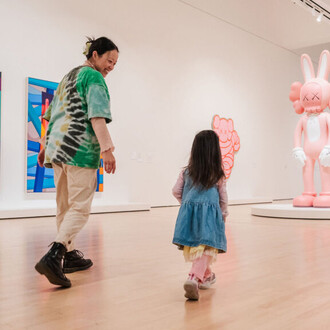Jenkins Johnson Gallery, San Francisco is pleased to present acclaimed British painter Annie Kevans: Women and the History of Art, October 2 through December 23, 2014. This isher first solo exhibition on the West Coast. Kevans’ series highlights successful female artists who have been overlooked or slow to be recognized by modern audiences. Kevans is one of Harper's Bazaar's “Forty Under 40” and New Woman's “Brit Hit List,” which described Kevans as the "new Tracey Emin". Concurrent with her solo show at Jenkins Johnson is a traveling exhibition of her series The Muses of Jean Paul Gaultier, featuring the designer's muses; Gaultier himself refers to the series as “fresh and contemporary”. The Fashion World of Jean Paul Gaultier is traveling from the Barbican in London to the National Galleries in Melbourne and Paris. This fall Kevans’ work is part of a four-person exhibition at Marres Centre for Contemporary Culture in Maastricht.
Kevans explores the relationship between power and identity through portraiture. Women and the History of Art celebrates female artists throughout history by re-introducing them onto the walls of galleries and museums. Building on the success of this ongoing series, which began with portraits of European artists from as early as the 16th century, the new works take on a broader and more American scope. The series includes forgotten Pop artists of the 1960s, black female artists such as Alma Thomas whose work is in the White House. She also recognizes artists who reached the spotlight by standing on the shoulders of their female predecessors, but whose success—such as in the case of Frida Kahlo and Georgia O’Keefe—is sometimes attributed to their artist husbands.
Kevans paints elegantly constructed composite portraits from existing images, imagination, and in some cases, the artists’ self-portraits. Kevans brings to light and challenges society’s perception of individuals and groups we may or may not remember. Whether child stars, dictators, or the insane, Kevans subjects possess a tangible humanity and sensuality. She believes that a person’s identity is not preset but is a shifting temporary construction, and her work questions our verdicts on history and perceptions of intellectual solidity.
The Women
Women and the History of Art directly relates to Kevans as a successful female artist herself in what is still a male-dominated art world (for example, only 5% of London galleries show an equal number of male and female artists). Kevans began looking for artistic role models and was surprised to discover a great number of important female artists who flourished and were celebrated during their lifetimes. As someone who describes herself as a “natural feminist”, Kevans was impassioned to uncover these successful but largely forgotten artists. An additional catalyst was her irritation upon being asked whether she would go back to the studio after the birth of her child—something that would not be asked of a male artist. After extensive research, Kevans found inspiration in artist mothers, like the 16th century Italian Lavinia Fontana, who had 11 children and was regarded as the first woman artist to work on a par with her male peers, painting altarpieces and papal portraits. Kevans choses to paint artists “who were as successful, and in some cases, more so, than their male counterparts,” but were often left out of the art historical canon and only recognized in the secondary realm of feminist art history. "Critics just didn't take women seriously," says Kevans. For example, art historian H.W. Janson admired the work of Idelle Weber, a female Pop artist whose work was purchased by the Museum of Modern Art in New York when she was only 25 years old. Janson told Weber, though, that he did not include women painters in his books. Weber is one of the many female Pop artists of the 1960s who were turned away by New York galleries. Kevans’ portraits include Pop artists such as Rosalyn Drexler, Idelle Weber, and Jann Haworth, who were swept aside in favor of white male Pop artists.
Acclaim by collectors and press
Kevans’ first series, Boys, depicts the young faces of some of the world's worst dictators. It was bought in its entirety by Charles Saatchi directly from Kevans' Central St. Martins School of Art & Design degree show in 2004 and put on public display at the Saatchi Gallery as part of his 2013 exhibition, Paper. The series was described as “the highlight” of the exhibition by The Globe and Mail. Kevans has had solo exhibitions in New York, London, and Vienna. Her work has been featured in numerous group exhibitions in the UK, Germany, Austria, Italy, and the US. She was a finalist in the Women of the Future awards and a finalist in the Jerwood Drawing Prize. Her work can be found in major collections, including the Pallant House Gallery, the David Roberts Collection, 21c Museum, the Saatchi Collection, as well as in the collections of Lord Rothermere, Stephen Fry, Marc Quinn, Adam Sender, and Jean Pigozzi, among others.



















